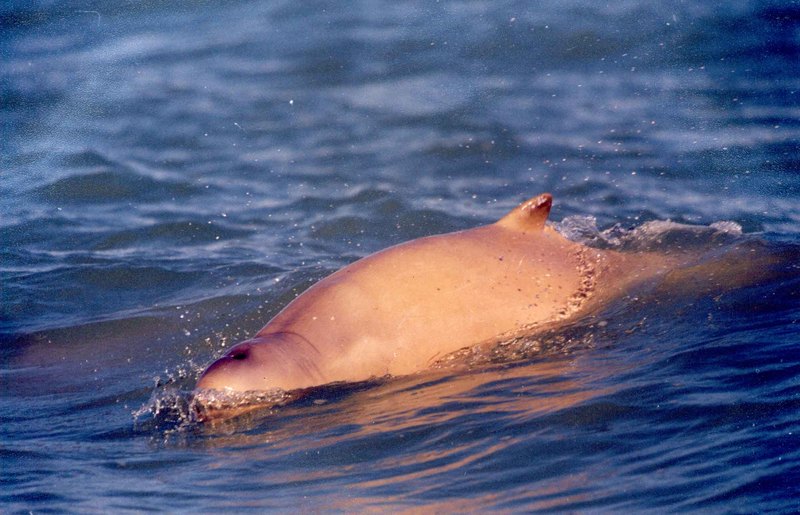Australian Snubfin Dolphin
From Wikipedia, the free encyclopedia
[Photo] A picture of an Australian Snubfin Dolphin (Orcaella heinsohni) taken by Isabel Beasley in 2005. Note smooth back and a crease separating head and back. Copyright (C) 2005 Isabel Beasley
Permission is granted to copy, distribute and/or modify this document under the terms of the GNU Free Documentation License, Version 1.2 or any later version published by the Free Software Foundation; with no Invariant Sections, no Front-Cover Texts, and no Back-Cover Texts. A copy of the license is included in the section entitled "GNU Free Documentation License". |
The Australian Snubfin Dolphin (Orcaella heinsohni) is a recently recognised species of dolphin, scientifically described in 2005.
It is closely related to the Irrawaddy Dolphin, and closely resembles it. Until very recently it was thought to be an Irrawaddy dolphin. However, the Australian Snubfin Dolphin is tri-colored, while the Irrawaddy dolphin only has two colors on its skin. Also the skull and the fins show minor differences between the two species.
The taxonomic name, Orcaella heinsohni, was chosen in honor of George Heinsohn, an Australian biologist who worked at James Cook University, "for his pioneering work on northeast Australian odontocetes, including the collection and initial analysis of Orcaella heinsohni specimens which form the basis for much of our knowledge of the new species."(Beasley, Robertson & Arnold 2005)
Discovery
New species of large mammals are quite rarely described nowadays, and those that are are usually from remote areas - such as the Saola - or are otherwise rarely encountered, see for example Perrin's Beaked Whale, or the Spade-toothed Whale which is only known from a few bones cast ashore. In fact, the Australian Snubfin is the first new dolphin species to be described in 56 years. It is unusual among recently-described mammals in that a population is accessible for scientific study.
Nonetheless, the existence of snubfin dolphins in the waters of northern Australia had only become known in 1948, when a skull was found at Melville Bay (Gove Peninsula, Northern Territory). This individual apparently had been caught and eaten by aboriginals. However, the discovery remained unnoted until discussed by Johnson (1964), and soon thereafter a Dutch skipper had his observaions of the then-unrecognized species published (M??rzer Bruyns 1966).
Two scientists, Isabel Beasley of James Cook University and Peter Arnold of Museum of Tropical Queensland, took DNA samples from the population of dolphins off the coast of Townsville, Queensland. They then sent the samples to the National Oceanic and Atmospheric Administration's Southwest Fisheries Science Center in La Jolla, California. The results showed that George Heinsohn was correct in his hypothesis (Arnold and Heinsohn 1996) that the Townsville population was a new species.
The holotype QM JM4721 (JUCU MM61) is the skull and some other bones of an adult male found drowned in a shark net at Horseshoe Bay, Queensland, on April 21, 1972. It was about 11 years old at the time of its death.(Beasley, Robertson & Arnold 2005)
Description
O. heinsohni is subtly three-colored: brownish on the top, lighter brown along the sides, and a white belly; the Irawaddy Dolphin, on the other hand, is uniformly slaty grey except for the white belly. The new species has a rounded forehead, very unlike other dolphin species in Australia, and the very small, "snubby" dorsal fin distinguishes it from other dolphins in its range. The lack of a groove on each side of the back and the presence of a neck crease further distinguishes this species from its relative.
Range and status
In the Pacific Ocean off Townsville, about 200 individual Snubfin dolphins were found. It is expected that the range of the species extends into Papua New Guinea - that is, O. heinsohni is endemic to the northern half of the Sahul Shelf -, but that the majority live in Australian waters. They are not thought to be common and are being given a high conservation priority. Its IUCN classification of "data deficient" refers to this species and the Irawaddy Dolphin combined (Cetacean Specialist Group 1996). Threats include drowning in fishery and anti-shark nets; while some hunting by indigenious people probably occurs (as evidenced by the 1948 specimen), this is likely to be insignificant compared to the threat posed by drowning.
http://en.wikipedia.org/wiki/Australian_Snubfin_Dolphin
| The text in this page is based on the copyrighted Wikipedia article shown in above URL. It is used under the GNU Free Documentation License. You may redistribute it, verbatim or modified, providing that you comply with the terms of the GFDL. |
|

